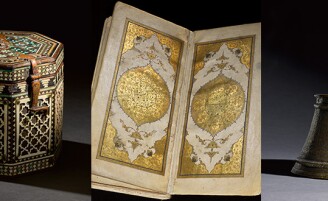S otheby's upcoming Arts of the Islamic World sale showcases art and literature that emerged throughout the civilisations which flourished under Islamic patronage from the seventh to nineteenth centuries. Among the Qur’anic and secular manuscripts, Persian and Indian paintings, ceramics, metalwork, jewellery, weaponry, and textiles that feature, this magnificent casket is of particular note. Learn more about this pinnacle of the artisan's trade by clicking the red hotspots below.

Taracea: a word derived from the Arabic tarsi‘, from the verbal root rs‘ meaning to stud or inlay. Taracea is principally an overlay rather than inlay technique using diminutive tesserae to create a ‘geometrical incrustation’.
The eight-pointed star is accentuated on the underside of the box, it is a motif characteristic of the Islamic worlds’ love of complex geometrical designs which if repeated would continue to infinity. Spot this design throughout the box.
The earliest example of geometric taracea from al-Andalus is on the minbar [the pulpit from which the imam delivers sermons] now in the Kutubiyya Mosque in Marrakesh. The minbar’s inscriptions state that it was produced in Cordoba on the orders of the Almoravid sultan ‘Ali b. Yusuf b. Tashufin, and it can be dated to between 1125 and 1130.

Minbar of the Kutubīyah Mosque © Qantara/DMLG Production This box belongs to a group of six similarly sized octagonal boxes. Five of this earliest group are closely linked in their use two techniques: geometric incrustation on the top and sides; carved open-work ivory panels on the sides. In all likelihood all these boxes originated from the same workshop in al-Andalus.
Octagonal box, wood inlaid with various types of wood and ivory and mounted with openwork ivory plaques. Iron fittings Spain, Granada; 14th century. I/2017 © The David Collection, Copenhagen. Photo by Pernille Klemp
A later example, of similar form, in metal, was sold at Sotheby's in 2014.
We are grateful to Julian Raby for cataloguing this lot.






